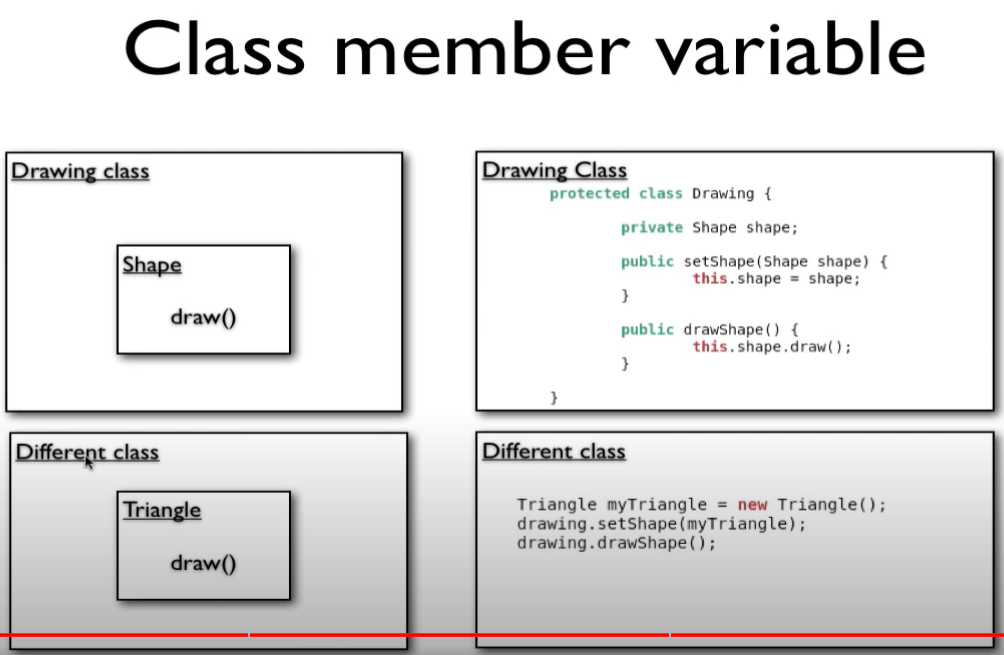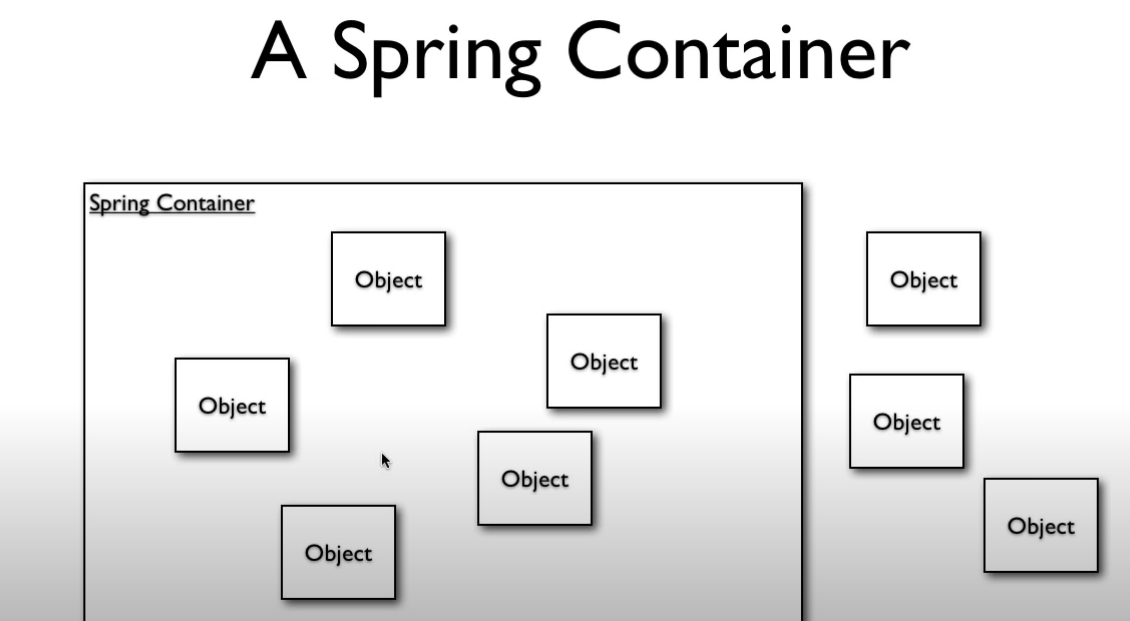Software Development => The only constant is change.
- Spring application is composed of many different components and when the application run, those components must be created and introduced with each other.
- Spring introduce the concept of container, which create and manage those components.
- These components/beans are wired together inside Spring Application Context.
- The Act of wiring components is done using pattern called Depdency Injection.
Rather than have components create and maintain the lifecycle of other beans that they depend on, a dependency-injected application relies on a separate entity (the container) to create and maintain all components and inject those into the beans that need them. This is done typically through 8constructor arguments or property accessor methods*.
Dependency injection is basically providing the objects that an object needs (its dependencies) instead of having it construct them itself. It's a very useful technique for testing, since it allows dependencies to be mocked or stubbed out.
It decouple the construction of classes from the construction of its dependencies.
- Historically, Spring application context used to wire beans together was with one or more XML files that described the components and their relationship to other components.
<bean id="inventoryService"
class="com.example.InventoryService" />
<bean id="productService"
class="com.example.ProductService" />
<constructor-arg ref="inventoryService" />
</bean>
- Now Java-based configuration is more common.
@Configuration
public class ServiceConfiguration {
@Bean
public InventoryService inventoryService() {
return new InventoryService();
}
@Bean
public ProductService productService() {
return new ProductService(inventoryService());
}
}
@Configurationannotation indicates to Spring that this is a configuration class that will provide beans to the Spring application context. The configuration’s class methods are annotated with@Bean, indicating that the objects they return should be added as beans in the application context
- Its is a design pattern in which an object or function receives other objects or functions that it depends on.
- How an object/function is created and then INJECTED where it's needed is the CRUX of Depependcy injection.
- In below example, myDrawMethod method have depency on Shape object.
- You create that object somewhere your application or within same file and pass/inject into the method.
- In example below, a class have an instance of
Shapeor you can say, class have adependencyofShapeobject. - You create and then inject it e.g; in the main class of this java program.
- Spring solve the problem of creating and injecting the dependency using XML.
- https://www.geeksforgeeks.org/pojo-vs-java-beans/
- https://stackoverflow.com/questions/1394265/what-is-the-difference-between-a-javabean-and-a-pojo?answertab=scoredesc#tab-top
- Spring is container of Beans.
- Spring behave as factory of beans => it produce those beans.
- As we discussed about in Dependency Injection, instead of creating your depdencies, someone else produce those depdencies. That someone else is called a FACTORY.
- To produce your depdency, FACTORY need sepcifications from you and then produce the depedency as per your specification.
- Dependencies also provide their specs to the FACTORY so that whenever someone ask for them, it can produce it.
- Spring is Container/Factory of Beans.
- It handle the instantiation, whole lifecycle, and destruction of objects.
- In Spring MVC, any class which has the annotation
@Controllercan handle HTTP requests.
import org.springframework.stereotype.Controller;
@Controller
public class Employee {
}
@RequestBodyannotation maps theHttpRequest bodyto a transfer or domain object, enabling automaticdeserializationof the inboundHttpRequest bodyonto a Java object.- Spring automatically deserializes the JSON into a Java type, assuming an appropriate one is specified.
@RequestMapping(method = RequestMethod.POST)
@ResponseBody
public HttpStatus something(@RequestBody MyModel myModel)
{
return HttpStatus.OK;
}
@RestController
public class HelloController {
@RequestMapping(path = "/v2/login", method = RequestMethod.POST)
public boolean validateLoginMapVersion(@RequestBody Map<String, String> login) {
if (login == null) return false;
String username = login.get("username");
String password = login.get("password");
// simple check
if ("mkyong".equalsIgnoreCase(username) && "123456".equals(password)) {
return true;
} else {
return false;
}
}
}
The @RequestBody annotation comes with the required attribute that defaults to true. Above all, this enforces that a request always contains body content. If not so, an exception is thrown. You can switch this to false if you prefer null to be passed when the body content is null.
@PostMapping("users")
@ResponseStatus(HttpStatus.CREATED)
public User registerUserCredential(@RequestBody User user, required=”false”)
- The
@ResponseBodyannotation tells a controller that the object returned is automatically serialized into JSON and passed back into the HttpResponse object.
@Controller
public class Employee {
@RequestMapping(value = "/employee", method = RequestMethod.GET)
@ResponseBody
public String hello() {
return "Hello World!!";
}
}
@RestControllerannotation combination of the@Controllerand@ResponseBodyannotation.
@RestController
public class Employee {
@RequestMapping(value = "/employee", method = RequestMethod.GET)
public String hello() {
return "Hello World!!";
}
}
1 - @RequestMapping with Class: We can use it with class definition to create the base URI.
@Controller
@RequestMapping("/home")
public class HomeController {
}
- Now
/homeis the URI for which this controller will be used.
2 @RequestMapping with Method: We can use it with method to provide the URI pattern for which handler method will be used.
@RequestMapping(value="/method0")
@ResponseBody
public String method0(){
return "method0";
}
3 - @RequestMapping with Multiple URI: We can use a single method for handling multiple URIs.
@RequestMapping(value={"/method1","/method1/second"})
@ResponseBody
public String method1(){
return "method1";
}
4 - @RequestMapping with HTTP Method: Sometimes we want to perform different operations based on the HTTP method used, even though request URI remains same. If you don't specify the method, method is GET
@RequestMapping(value="/method2", method=RequestMethod.POST)
@ResponseBody
public String method2(){
return "method2";
}
@RequestMapping(value="/method3", method={RequestMethod.POST,RequestMethod.GET})
@ResponseBody
public String method3(){
return "method3";
}
5 - @RequestMapping with Headers: We can specify the headers that should be present to invoke the handler method.
@RequestMapping(value="/method4", headers="name=pankaj")
@ResponseBody
public String method4(){
return "method4";
}
@RequestMapping(value="/method5", headers={"name=pankaj", "id=1"})
@ResponseBody
public String method5(){
return "method5";
}
6 - @RequestMapping with Produces and Consumes: We can use header Content-Type and Accept to find out request contents and what is the mime message it wants in response. For clarity, @RequestMapping provides produces and consumes variables where we can specify the request content-type for which method will be invoked and the response content type.
@RequestMapping(value="/method6", produces={"application/json","application/xml"}, consumes="text/html")
@ResponseBody
public String method6(){
return "method6";
}
7 - @RequestMapping default method: If value is empty for a method, it works as default method for the controller class.
@RequestMapping()
@ResponseBody
public String defaultMethod(){
return "default method";
}
8 - @RequestMapping fallback method: We can create a fallback method for the controller class to make sure we are catching all the client requests even though there are no matching handler methods. It is useful in sending custom 404 response pages to users when there are no handler methods for the request.
@RequestMapping("*")
@ResponseBody
public String fallbackMethod(){
return "fallback method";
}
@RequestMapping with @PathVariable annotation can be used to handle dynamic URIs where one or more of the URI value works as a parameter.
@RequestMapping(value="/method7/{id}")
@ResponseBody
public String method7(@PathVariable("id") int id){
return "method7 with id="+id;
}
@RequestMapping(value="/method8/{id:[\\d]+}/{name}")
@ResponseBody
public String method8(@PathVariable("id") long id, @PathVariable("name") String name){
return "method8 with id= "+id+" and name="+name;
}
@RequestMapping with @RequestParam for URL parameters in the request URL, mostly in GET requests.
@RequestMapping(value="/method9")
@ResponseBody
public String method9(@RequestParam("id") int id){
return "method9 with id= "+id;
}
For this method to work, the parameter name should be "id" and it should be of type int. If param name and variable name are the same, you can use could remove the "id" in @RequestParam.
@RequestMapping(value="/method9")
@ResponseBody
public String method9(@RequestParam int id){
return "method9 with id= "+id;
}
These mappings works exactly the same way as @RequestMapping except you don't have to specify the method as it's clear from the annoation name.
- Spring
@Valueannotation is used to assign default values to variables and method arguments. We can read spring environment variables as well as system variables using @Value annotation. Spring@Valueannotation also supports SpEL.
- We can assign default value to a class property using
@Valueannotation.
@Value("Default DBConfiguration")
private String defaultName;
ResponseEntityrepresents the whole HTTP response: status code, headers, and body. As a result, we can use it to fully configure the HTTP response.
@GetMapping("/hello")
ResponseEntity<String> hello() {
return new ResponseEntity<>("Hello World!", HttpStatus.OK);
}
// Different Status
@GetMapping("/age")
ResponseEntity<String> age(
@RequestParam("yearOfBirth") int yearOfBirth) {
if (isInFuture(yearOfBirth)) {
return new ResponseEntity<>(
"Year of birth cannot be in the future",
HttpStatus.BAD_REQUEST);
}
return new ResponseEntity<>(
"Your age is " + calculateAge(yearOfBirth),
HttpStatus.OK);
}
// Header Example
@GetMapping("/customHeader")
ResponseEntity<String> customHeader() {
HttpHeaders headers = new HttpHeaders();
headers.add("Custom-Header", "foo");
return new ResponseEntity<>(
"Custom header set", headers, HttpStatus.OK);
}
ResponseEntityprovides two nested builder interfaces: HeadersBuilder and its subinterface, BodyBuilder.
@GetMapping("/hello")
ResponseEntity<String> hello() {
return ResponseEntity.ok("Hello World!");
}
@GetMapping("/age")
ResponseEntity<String> age(@RequestParam("yearOfBirth") int yearOfBirth) {
if (isInFuture(yearOfBirth)) {
return ResponseEntity.badRequest()
.body("Year of birth cannot be in the future");
}
return ResponseEntity.status(HttpStatus.OK)
.body("Your age is " + calculateAge(yearOfBirth));
}
@GetMapping("/customHeader")
ResponseEntity<String> customHeader() {
return ResponseEntity.ok()
.header("Custom-Header", "foo")
.body("Custom header set");
}
- https://spring.io/projects/spring-boot
- https://start.spring.io/
- https://projectlombok.org/
- https://www.tutorialspoint.com/spring_boot/index.htm
- https://www.tutorialspoint.com/jackson/jackson_overview.htm
- https://howtodoinjava.com/series/spring-boot-tutorial/
- https://en.wikibooks.org/wiki/Java_Persistence
- https://www.youtube.com/c/JavaTechie
- https://www.youtube.com/c/LearnCodeWithDurgesh
- https://www.youtube.com/c/Telusko
- https://www.youtube.com/c/Freecodecamp
- https://www.youtube.com/c/amigoscode
- https://www.youtube.com/c/B2Tech
- https://www.youtube.com/channel/UC3hc8Ql0_OzMY7XI1gH9g8g/videos
- https://www.youtube.com/c/BrightBoost/videos
- https://www.youtube.com/c/JavaGuides/videos
- https://www.youtube.com/c/DanVega/videos
- https://www.youtube.com/c/JavaBrainsChannel
- https://www.youtube.com/c/JavaShastra/videos
- https://www.youtube.com/playlist?list=PLw_k9CF7hBpJJsRWAhwSrDlWAzuMV0irl
- https://www.youtube.com/c/JavaInspires
- https://www.youtube.com/playlist?list=PL9ooVrP1hQOEfi91PCFQMawtBJrPpir7y







